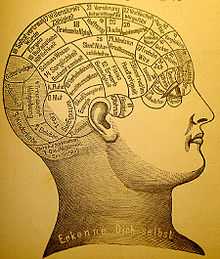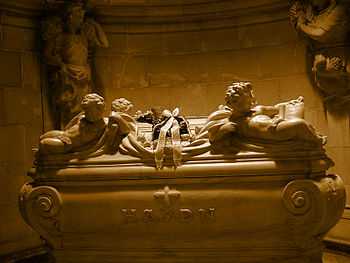Haydn's head
.jpg)
The celebrated composer Joseph Haydn died, aged 77, on May 31, 1809, after a long illness. As Austria was at war and the Viennese capital occupied by Napoleon's troops,[1] a rather simple funeral was held in Gumpendorf, the parish in Vienna to which Haydn's house on the Windmühle belonged, followed by burial in the Hundsturm cemetery.[2] Following the burial, two men contrived to bribe the sexton and thereby sever and steal the dead composer's head. These were Joseph Carl Rosenbaum, a former secretary of the Esterházy family (Haydn's employers), and Johann Nepomuk Peter, governor of the provincial prison of Lower Austria.[3] Rosenbaum was well known to Haydn, who during his lifetime had intervened with the Esterházys in an attempt to make possible Rosenbaum's marriage to the soprano Therese Gassmann.[4]

Peter and Rosenbaum's motivation was an interest in phrenology, a now-discredited scientific movement (see Franz Joseph Gall and Johann Spurzheim) that attempted to associate mental capacities with aspects of cranial anatomy. Of particular interest to phrenologists was the anatomy of individuals held to have exhibited great genius during their lifetime. (Sixteen years later, a similar attempt was made on the body of Ludwig van Beethoven, possibly for similar reasons.)[5]
The process of stealing the head was, apparently, not pleasant; since it had been eight days since the funeral, decomposition had set in and the smell was strong. However, Peter and Rosenbaum succeeded in cleaning the skull and duly carried out their phrenological examination. Peter declared that "the bump of music" in Haydn's skull was indeed "fully developed".[6] Afterward, Peter kept it in a handsome custom-made black wooden box, with a symbolic golden lyre at the top, glass windows, and a white cushion.
In 1820, Haydn's old patron Prince Nikolaus Esterházy II was inadvertently reminded by the chance remark of an acquaintance that he had forgotten to carry through his plan of having Haydn's remains transferred from Gumpendorf to the family seat in Eisenstadt.[7] When the remains were exhumed, the Prince was furious to find that they included no skull, and quickly deduced that Peter and Rosenbaum were responsible. However, through a series of devious maneuvers Peter and Rosenbaum managed to maintain possession of the skull. With both men's houses due to be searched, Peter gave the skull to Rosenbaum, who hid it in a straw mattress. During the search of Rosenbaum's house, his wife Therese lay on the bed and claimed to be menstruating—with the result that the searchers did not go near the mattress.[8] Eventually Rosenbaum gave Prince Esterházy a different skull.

On his death Rosenbaum willed the skull to Peter, with the proviso that on his own death Peter would will the skull to the Gesellschaft der Musikfreunde (Society of the Friends of Music) in Vienna, where it did indeed pass in 1895. The musicologist Karl Geiringer, who worked at the Society before the advent of Hitler, would on occasion proudly bring out the relic and show it to visitors.[9]
In 1932, Prince Paul Esterházy, Nikolaus's descendant, built a marble tomb for Haydn in the Bergkirche in Eisenstadt. This was a suitable location, since it is where some of the masses Haydn wrote for the Esterházy family were premiered. The Prince's express purpose was to unify the composer's remains.[10] However, there were many further delays, and it was only in 1954 that the skull could be transferred from the Gesellschaft der Musikfreunde to this tomb, thus completing the 145 year long burial process. When the composer's skull was finally restored to the remainder of his skeleton, the substitute skull was not removed. Thus Haydn's tomb now contains two skulls.[8]
Notes
- ↑ Webster (2002:43)
- ↑ Geiringer (1982:190)
- ↑ R (1932)
- ↑ Rice (2009). The marriage did ultimately take place in 1800, after Rosenbaum had left Esterházy employment.
- ↑ According to Beethoven's biographer, Anton Schindler, the gravedigger told him that he had turned down a bribe of 1000 florins for delivering the great composer's severed head. (Albrecht, 1996, p.215)
- ↑ Geiringer, 1982
- ↑ Specifically, to the Pilgrimage Church of Maria-Einsiedel; Hadden 1902
- ↑ 8.0 8.1 Hunting Haydn's Head, BBC Radio 4 broadcast by Simon Townley, 30 May 2009
- ↑ Geiringer (1947)
- ↑ M. M. S., 1948
Bibliography
Note: except where specified, all information was taken from the final chapter of Geiringer 1982.
- Albrecht, Theodore (1996) Letters to Beethoven and Other Correspondence: 1824-1828. University of Nebraska Press. ISBN 0-8032-1040-X.
- Geiringer, Karl (1947) Haydn: A Creative Life in Music, 1st edition. London: Allen & Unwin.
- Geiringer, Karl; Irene Geiringer (1982). Haydn: A Creative Life in Music (3rd ed. ed.). University of California Press. pp. xii, 403. ISBN 0-520-04316-2.
- Hadden, James Cuthbert (1902) Haydn. Text of the out-of-copyright biography is available on line from the Gutenberg Project at http://infomotions.com/etexts/gutenberg/dirs/etext03/hhmms11.htm.
- "M. M. S." (anonymous author) (1948). Review of Geiringer, Haydn: A Creative Life in Music, Music & Letters, Vol. 29, No. 2. (April), pp. 179–182. Available on JSTOR: http://links.jstor.org/sici?sici=0027-4224%28194804%2929%3A2%3C179%3AHACLIM%3E2.0.CO%3B2-U
- Pohl, Carl Ferdinand and Hugo Botstiber (1878) Joseph Haydn. Leipzig: Breitkopf & Härtel. Posted on line at .
- "R." (anonymous author) (1932) "The Skull of Joseph Haydn," The Musical Times, Vol. 73, No. 1076. (Oct. 1), pp. 942–943. Available on JSTOR: http://links.jstor.org/sici?sici=0027-4666%2819321001%2973%3A1076%3C942%3ATSOJH%3E2.0.CO%3B2-J
- Rice, John A. (2009) "Rosenbaum, Joseph Carl," in David Wyn Jones, ed., Oxford Composer Companions: Haydn. Oxford: Oxford University Press.
- Webster, James (2002) The New Grove Haydn. New York: St. Martin's Press.